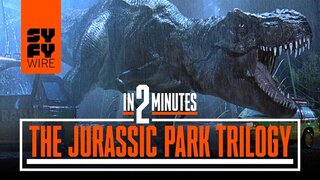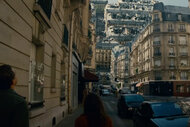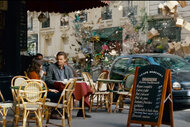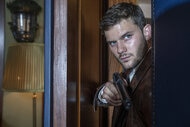Create a free profile to get unlimited access to exclusive videos, sweepstakes, and more!
30 Years Later, Jurassic Park Remains Visually Awe-Inspiring
How Steven Spielberg's dino-sized adventure thriller retains its magic despite three decades of visual effects advances.

It is impossible to overstate Steven Spielberg's influence on mainstream filmmaking. No matter how many words we devote to his work, his methods, or the impact of the individual films, we'll still be leaving something out, because the sheer breadth of the shadow he casts across the blockbuster landscape is just that all-consuming, and smarter film writers than me have spent decades trying to analyze why.
Simply put, Spielberg just has a way of seeing movies that makes him perfectly equipped to deliver the kind of spectacles audiences crave, so much so that even his less successful efforts have a certain charm and buoyancy to them that makes them watchable. A lesser Spielberg film is still better than another director's blockbuster masterpiece, and a top tier Spielberg is the kind of thing that can send ripples through the cinema landscape for decades, becoming a yardstick against which all other films of its kind are measured.
RELATED: Stream The Original Jurassic Park Trilogy on Peacock
It's been 30 years since its release in 1993, and Jurassic Park (now streaming on Peacock!) is still one of those films, a thunderous symphony of Spielberg's many popcorn movie powers that combines genuine human impact with jaw-dropping visual effects to deliver one of the great spectacles of 1990s cinema. All these years later, and those effects are still jaw-dropping, despite 30 years of visual effects advancement. You can watch Jurassic Park right now, or show it to someone who's never seen it, and still come away feeling like you were just refreshed by a wave of pure cinema bliss.
Why do Jurassic Park's visual effects hold up 30 years later?
So, why does Jurassic Park still work so well, even after five sequels in the same franchise and dozens of films that chased the same kind of lightning in a bottle? It's tempting to simply say that it holds up because it was made by a great filmmaker, and that's true, but since the film is turning 30 this month, let's take a brief, closer look at exactly why Jurassic Park endures, and the ingredients that make it one of the great blockbuster experiences.
Let's start with something simple: For all its focus on make-believe, and all the press it got back in '93 promoting the computer-generated imagery that brought some of the dinosaurs to life, Jurassic Park still feels remarkably tactile, and I don't just mean because Stan Winston and his crew actually built some of those dinosaurs in all their animatronic glory. There's a certain school of cinephile thought that suggests that practical effects are better than digital in every single case, but I don't just mean that Jurassic Park works because of the practical effects. If that were true, some of the raptor sequences wouldn't play as well as they do, and that legendary shot of Alan Grant looking out over the park for the first time wouldn't have the same impact.
No, I mean Jurassic Park is tactile because Spielberg makes you feel each piece of the environment he's delivering with a level of detail that many filmmakers can never quite muster. Let's look at just one example to get a tighter handle on what I'm talking about: The water in the little plastic cups in the tour Jeep. That shot of water rippling out in the cup, signaling the arrival of T. Rex with its thunderous steps, is one of the most famous shots in Jurassic Park because it's a great little detail that expresses the impact of what we're about to see.
But the thing is, that shot doesn't just work in isolation. It works because, just a few minutes earlier, we watched Dr. Malcolm use the same cups to flirt with Dr. Sattler, playing with droplets of water while discussing chaos theory. The two moments don't necessarily feel all that related, but by showing us the water in a benign way the first time, Spielberg has primed our brains for the callback. The same is true of the way the stainless steel cabinetry works in the raptor attack sequence; the way Dr. Grant's glasses come off his face in the park reveal shot; the way Dennis Nedry's desk looks in the control room; and so much more. It's all part of the same vision, and it reinforces that idea that this isn't just a make-believe place, but a whole world inhabited by people and creatures we can follow.
The other key ingredient, for me, is something Spielberg aficionados have commented on for years, and it's especially important in the context of films in which he's making actors look at things that aren't necessarily real: the way he shoots the human face. Spielberg and shots of wide-eyed, awestruck actors have become synonymous over the years for a reason, and it's especially clear why in films like Jurassic Park. There's a simple reason why it works: By showing us a human face reacting to the huge thing, rather than just the huge thing itself, he's rooting us in a certain emotional reality, a reality bolstered by hiring really good actors to do the reacting in the first place.
That's very evident when, for example, we're watching Alan Grant look out over a vast field of dinosaurs moving in a herd, and there's a reason why that shot is one of the most famous in the film. But it's not just those shots that do the heavy lifting here. Watch the sequence in which Dr. Malcolm is looking back at the T. Rex pursuing them, or the way the kids are simply listening to the raptors moving through the kitchen in certain shots. It's not just a self-evident sequence of shot/reaction shot/master shot cutting. It's Spielberg and his editor, the legendary Michael Kahn, dialing into very specific emotional frequencies as only they can. That means it doesn't matter that some of the raptor shots look a little dated, or that you can tell that all those dinosaurs out in the grassland are CGI, because we can feel the characters moving through a space that exists for them.
And then there's everything else: the dinosaur designs, the casting, the music from the great John Williams, the witty and propulsive script by Michael Crichton and David Koepp, and so much more. It's a film that fires on all cylinders in terms of craft, and that means it still plays great 30 years later. But it was never just that Jurassic Park was a fun watch; it's that Jurassic Park could leave our jaws on the floor and our eyes ready to bug out of our heads. Three decades later, it still can.


























